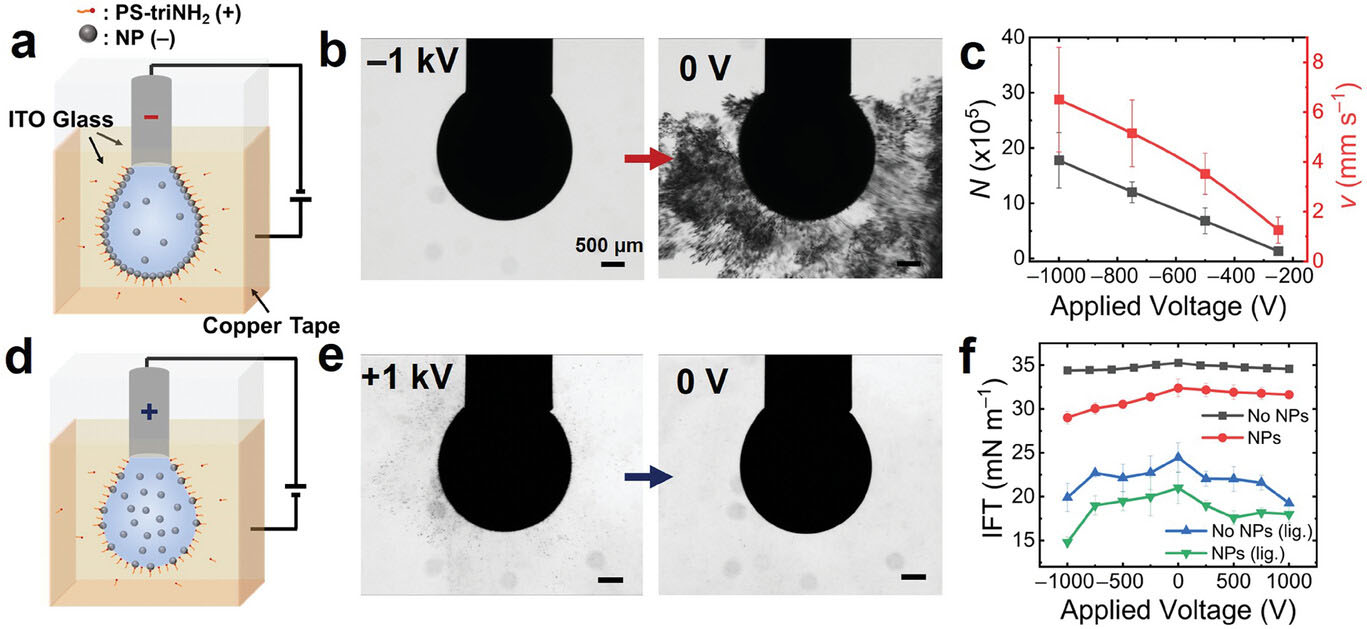| Mar 05, 2024 | |
Simple electric fields unleash autonomous liquid droplet propulsion |
|
| (Nanowerk Spotlight) Scientists have long sought ways to propel tiny liquid droplets autonomously, envisioning applications like miniaturized delivery vehicles or microrobotic systems. However, previous methods faced major limitations - they required specialized materials, continuous energy inputs, or could not control the direction and reversibility of motion. | |
| Now, a team led by researchers at Lawrence Berkeley National Laboratory has unveiled a radically new approach that harnesses electric fields to induce droplet propulsion through an effect they term "explosive emulsification." Their technique allows common liquid droplets containing simple metal oxide nanoparticles to be repeatedly propelled over large distances using just temporary electric field triggers. | |
| The research has been published in Advanced Materials ("Self-Propulsion by Directed Explosive Emulsification"). | |
| The key innovation is using the electric fields to deliberately oversaturate the droplet's surface with a jammed layer of charged nanoparticle-surfactant complexes. This packs the interface with huge reserves of electrostatic energy. Rapidly removing the field causes this energy to be explosively discharged, violently ejecting a plume of charged micro-droplets that recoil against the parent droplet and propel it in the opposite direction. | |
| "By packing the charged nanoparticles at the interface in this oversaturated state, we load it with electrostatic potential energy like a capacitor," explains lead author Xuefei Wu. "Then removing the field constraint unleashes that stored energy in an explosive ejection of micro-droplets, generating a powerful propulsive force." | |
| Crucially, the researchers showed this explosive propulsion mechanism works regardless of the chemical composition of the nanoparticles, a major advantage over prior approaches requiring specialized materials. Simple iron oxide or silica nanoparticles dispersed in water droplets and combined with an amine-based surfactant solution successfully demonstrated the explosive propulsion effect. | |
 |
|
| Schematic of the experimental setup. a,d) A pendant aqueous droplet is immersed in the toluene phase and hung at the end of a stainless-steel needle enabling application of a negative (a)/positive (d) bias voltage. The conductive chamber holding the polystyrene solution acts as the counter electrode; b) Optical images of the aqueous droplet (CFe3O4 = 1 mg mL−1) immersed in a PS-triNH2 solution (1 mg mL−1) in toluene under a bias voltage of −1000 V applied to the needle, and after the field is turned off; c) Total number, N, and mean velocity, v, of the jettisoned microdroplets generated during the explosive emulsification after different negative applied voltages are removed; e) Optical images of the aqueous droplet under the bias voltage of +1000 V applied to the needle, and after the field is turned off; f) Equilibrium IFT of a bare water/toluene (black squares), Fe3O4 NP dispersion (1 mg mL−1)/toluene (red circles), water/toluene solution of PS-triNH2 (0.01 mg mL−1) (blue triangles), and an aqueous dispersion of Fe3O4 NPs (1 mg mL−1)/toluene solution of PS-triNH2 (0.01 mg mL−1) (green triangles) under different applied voltages, where no spontaneous emulsification or explosive emulsification is observed. Scale bar: 500 µm. (Reprinted with permission by Wiley-VCH Verlag) (click on image to enlarge) | |
| "A key benefit is the universality - we can use cheap, readily available nanoparticles because the propulsion relies only on their electrostatic interactions at the interface, not their specific chemistry," notes Wu. "This makes the system much simpler and more versatile compared to previous approaches." | |
| By controlling the orientation of the applied electric field, the team induced directional asymmetry in the nanoparticle packing at the droplet surface. This concentrated the micro-droplet ejection plume towards one side, generating a recoil force that propelled the droplet rapidly in the opposite direction over distances up to ten times its own size. | |
| The researchers demonstrated a remarkable degree of control, with the ability to repeatedly reload the surface nanoparticle layer and cycle the explosive propulsion simply by re-applying the electric field. They could even steer directional changes by modulating the field orientation for each new propulsion event. | |
| "We can program complex trajectories for the droplet motions by carefully controlling the electric field sequence," says Wu. "This could enable applications like targeted cargo delivery or programmable microfluidic devices where the droplets navigate complex environments autonomously without requiring continual energy inputs." | |
| Looking ahead, the team envisions their explosive propulsion approach enabling multifunctional soft microrobotic systems that harness the intrinsic capabilities of tensioned liquid interfaces. By integrating payloads or responsive materials within the droplets themselves, they could create autonomous microscale platforms for localized sensing, fluid transport, or triggered material synthesis powered solely by the explosive micro-droplet ejections. | |
| "Our findings open up a new paradigm for engineering self-propelled liquid systems using commonplace materials and straightforward electric triggering," says corresponding author Thomas Russell. "With further research, these 'active droplet' concepts could catalyze innovations across fields like biomedical technologies, digital microfluidics and manufacturing processes requiring precise control over microscale liquid behaviors and transport phenomena." | |
 By
Michael
Berger
– Michael is author of three books by the Royal Society of Chemistry:
Nano-Society: Pushing the Boundaries of Technology,
Nanotechnology: The Future is Tiny, and
Nanoengineering: The Skills and Tools Making Technology Invisible
Copyright ©
Nanowerk LLC
By
Michael
Berger
– Michael is author of three books by the Royal Society of Chemistry:
Nano-Society: Pushing the Boundaries of Technology,
Nanotechnology: The Future is Tiny, and
Nanoengineering: The Skills and Tools Making Technology Invisible
Copyright ©
Nanowerk LLC
|
|
|
Become a Spotlight guest author! Join our large and growing group of guest contributors. Have you just published a scientific paper or have other exciting developments to share with the nanotechnology community? Here is how to publish on nanowerk.com. |
|
